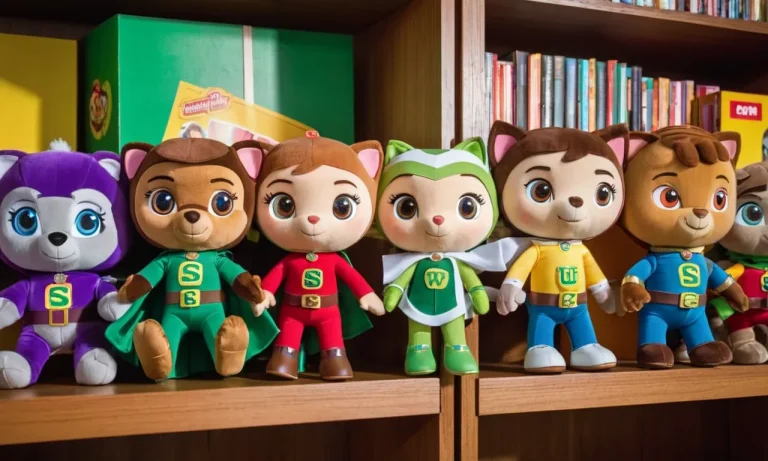That beloved stuffed animal keeping your child company may also be harboring some unwanted guests – germs. If you’ve ever wondered exactly how long germs can live on your child’s plush toys, you’re not alone.
The short answer is that most germs can survive on the surface of stuffed animals for hours to days if not cleaned properly. Flu viruses specifically may last up to 48 hours.
Read on as we provide a detailed guide examining how various factors like material, environment, and type of germs impact stuffed animal germ lifespan. We’ll also offer proven cleaning tips to help kill germs and keep your child’s stuffed pals free of nasty microbes.
What Types of Germs Live on Stuffed Animals
Bacteria
Stuffed animals can harbor various types of bacteria, including Staphylococcus, Streptococcus, Salmonella, and E. coli. These bacteria thrive on the fibers and materials of stuffed toys. Research shows that 69% of stuffed animals tested positive for Staphylococcus, with 10-20% containing antibiotic-resistant strains (source).
Bacteria accumulation increases over time as children touch and cuddle stuffed toys.
Viruses
Viruses like the common cold and flu virus can survive on the surface of stuffed toys for up to 48 hours. Stuffed animals used in doctor’s offices or hospitals may also come into contact with contagious viruses.
The SARS-CoV-2 virus that causes COVID-19 has been found to persist on plush surfaces for up to 5 days (source). Fortunately, most viruses are susceptible to cleaning agents.
Fungi
Mold and fungi growth can occur inside stuffed animals that remain damp for prolonged periods. These spores thrive in the stuffing material and dark, humid conditions inside stuffed toys. In a study examining toy contamination, over 53% of plush toys showed mold contamination.
Dust mites feed on mold and fungus (source). Toys kept in warm, moist areas are most vulnerable to fungi overgrowth.
Dust Mites
Microscopic dust mites feast on the dead skin cells, mold, and fungus inside children’s stuffed animals. These creatures are invisible to the eye but can trigger allergic reactions and breathing issues in sensitive kids.
One study found an average of 4,000 dust mites per gram in contaminated stuffed animals (source). To limit mites, wash and thoroughly dry stuffed toys to remove organic debris they feed on.
| Germ Type | Transmission | Persistence |
|---|---|---|
| Bacteria | Contact with contaminated surfaces | Days to weeks |
| Viruses | Respiratory droplets or contact | Hours to days |
| Fungi | Spores in humid, damp areas | Weeks to months |
| Dust Mites | Microscopic particles in dust | Months to years |
Main Factors Impacting How Long Germs Survive on Stuffed Toys
The Material and Texture
The materials stuffed animals are made of is key in determining germ survival rates. Plush stuffed animals with smooth surfaces like polyester don’t allow germs to accumulate and thrive. On the other hand, materials like cotton with uneven and porous surfaces provide perfect hiding spots for germs to cling to and multiply.
Fur, felt, velour, corduroy, and other fabrics with fibrous textures also make it easy for germs to embed themselves and survive longer. Studies show bacteria can live for up to 90 days on fabrics, compared to just hours or a couple days on hard, nonporous surfaces.
Environmental Temperature and Humidity
Warmer environments allow germs to thrive and live longer. Germs also prefer damp conditions. So leaving stuffed animals in humid places like bathrooms or areas exposed to moisture will extend germ viability.
Colder and drier areas impede germ growth. But most germs can still persist hours or days on stuffed toys at room temperature. Freezing temperatures are required to completely halt most microbial activity.
| Temperature/Humidity | Germ Viability |
|---|---|
| Hot and humid | Up to months |
| Room temperature | Days to weeks |
| Refrigerated | Hours to days |
| Frozen | Dormant |
Type of Germs Present
How long germs survive depends on the specific organism. Hardy germs like norovirus and Staphylococcus aureus bacteria may persist for weeks or months. More delicate germs like influenza virus typically die off faster within 48 hours.
Some common stuffed animal germs and their average viability:
- Norovirus – Weeks to months
- Staph – Days to months
- Strep – Days
- E. coli – Days to weeks
- Salmonella – Days to weeks
- Cold and flu viruses – 48-72 hours
So in general, viruses don’t live as long as resilient bacteria. But even after germs are no longer viable, their DNA can linger on surfaces. Routine stuffed animal cleaning is key.
Exact Germ Lifespans on Stuffed Animals by Type
Bacteria Lifespans
Bacteria like Staphylococcus aureus and Escherichia coli can survive on the fabric of stuffed animals for quite a long time. Studies show that bacteria can persist for up to 90 days on plush toy surfaces if not cleaned properly.
The key factors that influence bacterial lifespan include temperature, moisture level, sunlight exposure, and nutrient availability. Warm, damp environments allow bacteria to thrive for longer periods. Direct sunlight and regular cleaning help lower bacteria levels.
Virus Lifespans
Viruses like cold and flu viruses can persist on stuffed toy surfaces for up to 48 hours. Enveloped viruses are more sensitive and may only survive up to 8-12 hours based on the material. Virus survival depends on the strain, surface porosity, temperature, and humidity.
Viruses die off quickest on non-porous surfaces like plastic eyes. Porous fabric allows viruses to penetrate deeper and survive longer (up to days). Proper washing and drying helps destroy stubborn viruses.
Fungi Lifespans
Mold and fungi thrive on the stuffing inside plush toys if moisture gets trapped internally. The optimal temperature for fungal growth is between 70-80°F. Without cleaning, the fungi can feed on organic debris and even embed spores deep in the fibers.
Tropical environments accelerate the mold growth process to just 48-72 hours if not dried properly. Fungi may persist indefinitely on unwashed stuffed toys leading to associated health risks.
Dust Mite Lifespans
Microscopic dust mites feast on the dead human skin cells that accumulate on bedding and plush toys. The average lifespan of a dust mite is about 100 days depending on humidity and availability of skin cell debris to eat. An adult female dust mite can lay up to 100 eggs over a 2-3 week period.
So mite infestations on stuffed animals can explode in as little as 10-14 days in ideal warm, moist conditions. Regular hot water washing keeps their numbers down.
| Germ Type | Lifespan on Toy Surface |
|---|---|
| Bacteria (e.g. Staph, E. coli) | Up to 90 days |
| Viruses (e.g. flu, cold) | 8-48 hours |
| Fungi/Mold | Indefinitely without cleaning |
| Dust Mites | Rapidly multiply in 10-14 days |
As we can see, germs can persist for alarmingly long periods on kids’ plush toys. The optimal solution is washing stuffed animals frequently (weekly) in hot, soapy water. Check out this article for proper cleaning guidelines. Keeping our stuffed friends hygienic promotes good health!
Cleaning and Disinfecting Stuffed Animals
Washing Machine & Dryer
One of the best ways to clean most stuffed animals is to wash them in the washing machine and dryer. Check the tag first to see the manufacturer’s recommendations. Many modern plush toys are machine washable if you use a gentle cycle and cold water.
Make sure to zip up zippers and Velcro closures so they don’t snag on other items. Washing helps remove dirt, bacteria, viruses, dust mites, and allergens that can accumulate on the surface over time. According to the American Cleaning Institute, the hot water in a washing machine can kill over 99% of bacteria and germs during the wash cycle.
After washing, dry stuffed animals completely in the dryer if possible per the tag instructions. The heat from the dryer helps kill germs and sanitize the toys. If air drying, be sure to completely dry all areas. Leaving moisture behind can allow mold and bacteria to regrow quickly.
Make sure to fluff the pile while drying so the fibers don’t mat.
Hand Washing
For stuffed animals not suitable for the washing machine, hand washing is the next best option. Fill a sink, tub, or bowl with cool water and a small amount of mild laundry detergent. Allow toys to soak for several minutes, then gently scrub across the surface, getting into folds and crevices.
Rinse thoroughly with clean water. Shape the pile and air dry completely before allowing a child to reuse the toy.
According to WebMD, hand washing helps remove many bacteria when done properly. 👍 It may not sanitize as fully as machine washing, but can freshen up and extend time between deeper cleanings. Just be careful not to submerge any electronic components fully in water when hand washing.
Spot Cleaning
For minor soiled spots on stuffed animals, spot clean the area with a small amount of gentle laundry detergent, a gentle baby wipe, or an all-natural cleaning spray. Lightly scrub only on the affected area, then pat dry with a clean towel.
Allow time to fully air dry before letting your child reuse their snuggly companion.
Spot cleaning allows you to target problem areas in between fuller washings. It helps keep toys fresher for kids to love for longer. 😊 Just take care not to oversaturate the area or leave moisture behind, which can grow mold.
Disinfectant Sprays and UV Light Sanitizers
There are also special stuffed animal disinfectant sprays designed to kill germs between washings. Popular brands for these toy cleaners include Babyganics, Lysol, Mommy’s Helper, and Buddy Bowl Disinfectant Spray. Always check that a spray is specifically safe for use on plush toys before applying.
UV light sanitizer boxes for stuffed animals and other children’s items use powerful ultraviolet light targeted to kill up to 99.9% of germs and bacteria without harsh chemicals. They can be a great addition for disinfecting between washes.
Popular brands for at-home use include those made by HoMedics, Verilux, and PhoneSoap.
| Method | Pros | Cons |
|---|---|---|
| Washing Machine | -Deepest clean-Hot water kills germs | -Not for all fabrics-Can damage electronics-Time consuming |
| Hand Washing | -Gentle-Better than nothing | -Won’t fully sanitize-Time consuming-Must completely dry |
| Spot Clean | -Quick-Targets problem areas | -Surface level clean-Doesn’t disinfect fully |
| Disinfectant Sprays | -Convenient-Designed for stuffed animals | -Does not fully clean-May not penetrate fully |
| UV Light Sanitizers | -Uses light to kill germs-No chemicals | -Expensive-Bulky equipment -Limited interior penetration |
As you can see, each method has pros and cons. For the deepest and most thorough cleaning, washing machine and full air drying is best if the toy allows. 👍 Disinfecting sprays and UV light can also help freshen and extend time between full wash cycles.
With some care, you can keep your child’s beloved plush pals clean and happy for years of love and snuggles to come! 😊
Stuffed Animal Care Tips to Prevent Germs
Wash Hands Before Play
Washing hands with soap and water for at least 20 seconds before playing with stuffed animals is one of the most effective ways to prevent the spread of germs. According to the CDC, handwashing reduces the number of germs on hands by up to 99%.
When kids forget to wash up before playtime, they can transfer germs like cold and flu viruses, streptococcus bacteria, and even pinworm eggs onto their stuffed animals and toys.
To encourage good hand hygiene, make handwashing a fun routine before play by singing songs or using glitter germ lotion to visibly demonstrate the removal of germs. Place kid-friendly soap, step stools, and hills and valleys textured sink mats at kids’ height to make it easy for them to wash properly.
And be sure to set a good example by washing your own hands first!
Keep Off Floors and Dirty Surfaces
When stuffed animals inevitability end up on the floor, they can collect germs like E. coli, salmonella, and mold spores. Prevent this by designating baskets, shelves, or bins for stuffed animal storage. For extra protection, use washable, removable liners in storage bins.
It’s also important to keep stuffed animals away from dirty surfaces like the bottom of shoes, trash cans, toilets, and diaper pails. Not only are these areas crawling with germs, but contamination can be harder to remove from a stuffed animal’s fur or fabric.
Separate Piles for Different Kids
While sharing stuffed animals can teach kindness, it also spreads more germs between kids. According to a 2020 study, cold and flu viruses can survive on fabric surfaces for up to 48 hours. To reduce sharing germs, consider giving each child their own special stuffed animal.
For communal stuffed animals, create separate piles for different kids. Use laundry baskets or reusable cloth bins with each child’s name. Rotate and wash communal stuffed animals frequently to prevent one child’s germs from living there too long.
Wash and Disinfect Regularly
| Surface | Cold & Flu Virus Survival Time |
| Skin | 15 minutes |
| Cloth & Fabric | 48 hours |
| Plastic & Metal | 72 hours |
According to studies, cold and flu viruses can cling to the fabric surfaces of stuffed animals for up to 48 hours. That’s why regular washing is key. Rule of thumb: if a stuffed animal comes in contact with a child’s mouth or nose, it’s time to wash it.
Check manufacturer label instructions for washing guidance. Many machine-washable stuffed animals recommend washing cycles on gentle/delicate setting using a non-bleach detergent and cool water temperature. For non-washables, use disinfectant wipes on the surface.
Make washing stuffed animals part of your family’s routine health and germ prevention. With some concerted prevention measures, your kids’ stuffed pals can stay safe, clean, and germ-free for all their adventures together.
Conclusion
We hope this guide gave you a detailed understanding of exactly how long germs can survive on stuffed animals based on different factors. While it’s next to impossible to keep plush toys completely germ-free at all times, following proper cleaning methods and basic care tips can help minimize health risks.
The most important stuffed animal care guidelines include washing regularly, spot cleaning after contamination, keeping off dirty surfaces, and practicing good hygiene. Following these simple stuffed animal cleaning protocols will keep your child’s beloved plush pals safer and cleaner.







